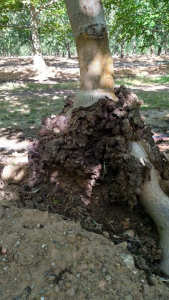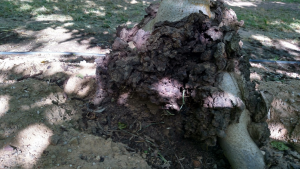Most walnut growers are familiar with crown gall, and some employ strategies at planting to help prevent infection. However, one question I’m often asked by new growers is how to decide what to do with a young (1st-4th leaf) tree with crown gall. They ask: what’s the worst that can happen?

Severe crown gall infection on a 12 year old walnut tree. The trunk diameter is significantly smaller than healthy trees around it. Photo: D. Lightle.
This tree has crown gall around 100% of the trunk. I can’t predict how long it will continue to live, but it will never produce like a healthy tree. The trunk diameter is significantly smaller than the surrounding trees and the canopy is size reduced. At some point, the gall will restrict water and nutrient movement enough that the tree will die.
The tree should have been removed or treated when it was younger. If it is a young tree and 50% or more of the circumference is infected, I recommend removing and replanting the tree. For smaller galls, treatment may be an option, however it is expensive and not all trees will have 100% gall removal. If a high proportion of the trees are infected, it becomes a judgement call on whether it is better to replant or live with the trees you have. When replanting, consider using RX1 rootstock since it has the highest resistance to crown gall of the clonal Paradox rootstocks available.

Large crown gall infection on 12 year old walnut tree. Photo: D. Lightle


Leave a Reply